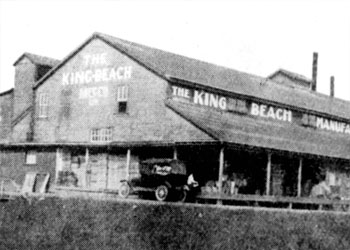The Cannery Building
Location:
6967 Bridge Street
Historic Neighbourhood:
Flats
Date of Original Construction:
ca. 1890
Category:
Industrial
Status:
Multiple businesses exist where the building once stood
Description:
Originally a wood frame industrial building, modified over the years for various uses, primarily food processing. It was located on the corner of Harbour and Bridge Street, at the North end of the CPR Bridge. The CPR tracks run behind the building (west side) which was essential for freight. There is currently a newer cinder block building on the site, occupied by Monague Crafts Ltd.
Also known as: Truro Condensed Milk Co. (1900 to 1910), the Kootenay Jam Company (1911-1914), King-Beach Manufacturing Co., Farmers’ Canning Coop (1922-?), and Canadian Canners Company (1924-1957)
History:
The building was originally built as a fish cannery. By the 1900’s it was being used as a milk cannery. The Western Condensed Milk, Cannery, Coffee and Creamery Company ran a paddlewheel boat along the Fraser from Nicomen Island to Mission. The boat picked up approximately six tons of milk a day and delivered it to the plant where it was processed into Rocky Mountain Truro Condensed Milk and Hilt Edge Butter and shipped to White Rock, New Westminster, and Vancouver. Competition from the BC Electric Railway on the south side of the river opened new markets to the dairy farmers, and the milk plant could no longer compete, closing down in 1910.
The building was sold and re-opened as the Kootenay Jam Factory in 1911; head offices were in England, and the plant was moved to Mission from Nelson, B.C. The site was a building 75 by 100 feet covering eleven lots. Extensive additions and new machinery were added. When completed, the factory was over 230 feet long and at points eighty feet wide. In the first year of operation, the plant processed twenty tons of raspberries, fifteen tons of strawberries, five tons of gooseberries, and five tons of currants. Products were shipped to Vancouver by train.
In 1915 it was bought out by the King-Beach Chocolate and Jam Factory. Purchased first by Mr. Harry Beach for processing jams, a partnership with Mr. R.P. King soon resulted in the addition of new products. By producing chocolate during the slower season when fresh produce was not available for jam, the company was able to remain open all year. The factory employed fifty women at two dollars a day. Local milk was used in the manufacture of chocolate bars and the “big puff cherry chocolate”, which also contained a generous amount of brandy.
Following the war, the berry market was booming, and prices increased from five cents a pound to twenty-two cents a pound in 1921. Many farmers bought into the newly formed Fruit & Mercantile Company. Part of the King Beach property was sold to Associated Growers, who kept Mr. Beach in charge of their operations. In 1922, the rest of the plant was bought by the Anglo BC Packing Co (salmon packers) who ran the business until 1924 when it was sold to the Canadian Canners Co., which was in turn bought by Aylmer, who continued operation until 1957. Hundreds of seasonal workers were kept busy processing beets, corn, peas, and beans. The Mission Archives has a wealth of oral histories about working in the food processing plants.
Evidence of the age of the building could be seen on one of its walls where the 1894 flood had left its mark. In 1948, the building was again flooded up to ten feet. An aerial photograph from 1963 shows the building was still standing at the time. However, a 1974 aerial photograph shows the buildings on the site demolished and a new building being constructed.
People Associated with the Site:
When Kootenay Jam Co. was owned by R.N. Brassey, B.H. Fox, and G.O.M. Fox. Brassey served as president, while the other two served as secretary-treasurer and managing director, respectively. Miss McLeod worked for their company as a stenographer. Mr. A. Catherwood worked on the renovations to the building before the Kootenay Jam Factory opened. Later on, when the Canadian Canners Co. bought the factory, Ella Windebank worked as the secretary.
Architectural Features:
In 1911, additions were made, including a large machinery hall, which would house the principal machines. This addition was sixty feet long by thirty feet wide by twelve feet high; entirely free from obstructions in the way of columns, etc. and the floor was cement. Several other rooms were built to accommodate the different machines and departments including a storeroom, pulp room, boiling room, glass washing, packing room, sugar room, boiler and engine house, dynamo, and labeling room. The boiler had 120 horsepower with a seventy-foot smoke stack; this landmark by the river could easily be seen from most of Mission. The second story contained offices and a room used for storage. Altogether the new portion of the building was of a capacious and convenient design.
Where to get further information:
The Mission Community Archives
Sleigh, Daphne. Mission As it Was. Mission District Historical Society, 2017, pg. 35.
Beach, Harry. Oral History, Transcript. 1975.
The Historian, Mission District Historical Society, Fall 2007 newsletter, pg. 1, 5.
File 250.1 F.
File 250.20.47.
File 250.1-K.
File 250.47.
Fraser Valley Record. April 20, 1911.
FVR. April 27, 1911.
FVR. May 4, 1911.
FVR. June 8, 1911.
FVR. June 22, 1911.
FVR. August 3, 1911.
FVR. August 10, 1911.
FVR. October 26, 1911.
FVR. December 7, 1911.
FVR. January 25, 1912. pg.5.
FVR. November 20, 1913. pg. 8.
FVR. March 19, 1980.
Insurance Maps. Originals can be found at City Hall.
Pr 252-1 Truro Condensed Milk Co. ca 1910
Pr 252-2 Truro inside ca 1910
Pr 110-13A Kootenay Jam Factory ca 1911-1915
Pr 265-47 Kootenay Jam Factory ca 1911-1915
Pr 111-2 Kootenay Jam Factory ca 1911-1915
Pr 44-20 King Beach Factory 1916
Pr 44-21 King Beach Factory 1916
Pr 36-5 Cannery Crew 1919
Pr 122-25A King Beach Factory Workers
Pr 246-6 Farmer’s Canning Company 1927
Pr 3-12 Opening CPR Bridge to car traffic 1927
Mission Museum. A collection of memorabilia from the different companies that used the building.
City Hall. Aerial Photographs and Fire Insurance Maps of the area. LOCATION.
The Heritage Places collection of images includes the following:
– King Beach Factory (HP)
– Harry Beach Fonds – Fruit Images (HP)
– King Beach Stamp (HP)



